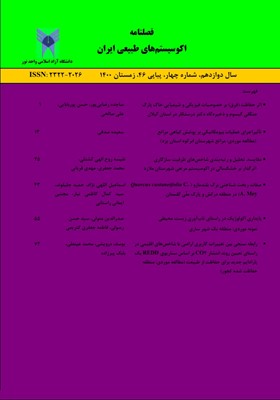تأثیراجرای عملیات بیومکانیکی بر پوشش گیاهی مراتع (مطالعه موردی : مراتع شهرستان ابرکوه استان یزد)
محورهای موضوعی : مرتعداری
1 - اداره کل منابع طبیعی و آبخیزداری استان یزد
کلید واژه: اصلاح و احیاء مراتع, ذخیره نزولات آسمانی, هلالی آبگیر, مراتع استان یزد,
چکیده مقاله :
اجرای عملیات ذخیره نزولات از مهمترین روش های اصلاح و احیاء پوشش گیاهی مراتع محسوب می شود. تحقیق حاضر با هدف بررسی تأثیر ذخیره نزولات بر فاکتورهای پوشش گیاهی مراتع قشلاقی شهرستان ابرکوه استان یزد انجام شد. موفقیت عملیات بیومکانیک از طریق اندازه گیری و آنالیز آماری فاکتورهای پوشش گیاهی شامل درصد تاج پوشش، تولید، زادآوری و تراکم در چهار تیمار شاهد، پیتینگ، کنتورفارو و چاله های هلالی آبگیر مورد ارزیابی قرار گرفت. نمونه برداری به روش تصادفی - سیستماتیک و با استقرار ترانسکت و پلات صورت گرفت. داده ها به روش آنالیز واریانس یک طرفه ANOVA تجزیه و تحلیل شد. نتایج نشان داد که فاکتورهای مورد بررسی در سطح آماری یک درصد (P<0.01) دارای اختلاف معنی داری بودند. به گونه ای که میزان درصد تاج پوشش، تولید، تراکم و زادآوری گونه های گیاهی در روش هلالی آبگیر به ترتیب با 5/8، 25/39، 6/6 و 9/3 بیشترین مقدار را در مقایسه با دو روش دیگر داشت و این فاکتورها در روش های کنتور فارو و پیتینگ اختلاف معنی داری با شاهد نشان ندادند. نتایج این تحقیق نشان داد که احداث هلالی های آبگیر نسبت به روش های کنتور فارو و پیتینگ تأثیر بیشتری در افزایش پوشش گیاهی منطقه دارد.
Execution of rainfall storage operationsis is one of the most important methods of improving and restoring rangeland vegetation. This study was conducted to investigate the effect of rainfall storage on vegetation factors in winter rangelands of Abarkooh, Yazd. The success of biomechanical operations was evaluated through the analysis of vegetation factors including canopy cover, production, regeneration, and density in four treatments: control, pitting, contour furrows, and crescent ponds. The sample was selected through random – systematical method of sampling with the establishment of transects and plots. One-way between groups ANOVA was run in order to analyze the data. The results showed that the studied factors had a significant difference at the statistical level of one percent (P <0.01). So that in the crescent ponds method Percentage of canopy, production, density and regeneration of plant species had the highest value with 8.5, 39.25, 6.6 and 3.9, respectively, in comparison with the other two methods. These factors did not show a significant difference with the control in contour furrows and Pitting methods. The results of this study showed that crescent ponds had a greater effect on restoration and increase of vegetation compared with contour furrows meter and pitting methods.
_||_

